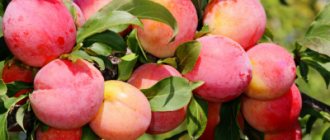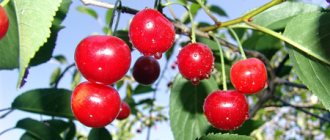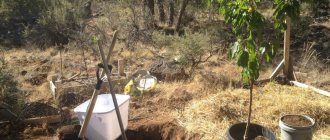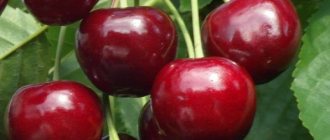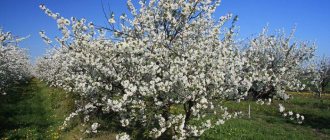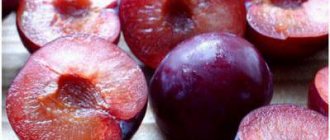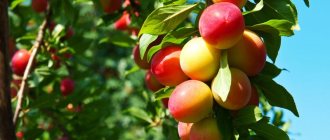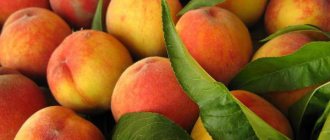History of origin and region of growth
Experts all over the world are actively engaged in the selection of fruit plants. The work of domestic geneticists and breeders has been noted for remarkable success. The Priusadnaya Yellow cherry variety was created in Russia by crossing the Leningradskaya Red and Zolotaya Loshitskaya varieties with subsequent neural irradiation. And together with other new fruit stone fruits, it confidently took an honorable place in the household farms of the Central Black Earth Region.
In recent years, our climate has been softening. In the reviews there are comments about a successful trial of growing cherries in more northern territories. But there they give the plant a slate-like shape, gradually tilting the seedling closer to the ground from year to year, while at the same time, by pruning, giving the crown the necessary shape. An extremely challenging and interesting experience.
Diseases and pests
The cherry variety Homestead yellow is highly resistant to diseases and pests. It does not require special preventive measures or treatment, does not need pollinators, and is therefore recommended for cultivation in home gardens. The main problem when cultivating this variety is the inability to fully realize the resulting harvest. If the tree is not formed correctly, limiting its growth, then soon it will be impossible to get berries. This will make them prey for birds. You cannot cover a high crown with a net.
If the height of the tree is limited in time, then it will be possible to throw a bird net over the cherry tree
There are water bowls in my garden. For some reason, it was previously believed that birds pecked berries to quench their thirst. But observations suggest that even if there are drinking bowls on the site, the feathered robbers prefer sweet berries. It’s probably worth leaving some of the berries for sparrows and tits, hoping that later the lured birds will turn their attention to insect pests after the cherries.
Description of the cherry variety Homestead yellow
Tree height and crown branching
The yellow cherry grows very quickly. If the gardener does not control the growth in a timely manner, by the time of fruiting the height of the tree can reach 4-5 m. This will create many problems when harvesting and protecting it from birds. Although, according to some reviews, yellow-fruited cherries do not seem to tempt them. That would be an extra big plus.
The massive trunk and tiered arrangement of cherry shoots represent a spreading, spherical, well-leafed crown with a radius of up to 4 m. But it cannot be called very thick, so formative pruning and harvesting are not particularly difficult.
Trimming
Homestead yellow cherries need proper crown formation. To do this, immediately after planting a young tree, its branches are pruned. The procedure can also be performed in May or early June. This procedure will stimulate the growth of lower branches. This will also speed up the fruiting process.
When pruning, it is not recommended to leave an unbranched seedling 1 m long. Otherwise, subsequent shoots will grow even higher. In this case, it will be difficult to pick berries. Branches with 4-5 buds up to 50 cm long should be left.
If the young branches of an annual seedling are cut too short (less than 35 cm), the growth of the tree will increase and fruiting will slow down. Therefore, pruning must be carried out competently, following the recommendations of experienced gardeners.
During sanitary pruning, you can also remove dried or diseased branches. This stimulates the fertility of the cherry. In this case, the tree will be healthy and strong.
Having looked at what homestead yellow cherries are, as well as having studied the features of their care and planting, every gardener will be able to grow the presented tree on their plot. Its high yield and high taste of the fruit make the presented variety popular and widespread in our country.
Pollinators, flowering and yield
A huge advantage of Homestead Yellow is its self-pollinating ability. It was noticed that the proximity to other pollinators could increase the yield. But how can we increase it given its productivity? She herself, in turn, is a good pollinator and a valuable honey plant.
Cherry blossoms early: in early May. Elegant inflorescence bouquets of 3-5 wonderful white flowers are resistant to frosty May mornings. Homestead yellow cherries begin to bear fruit at the age of 6 years. But then every year it rewards with an enviably high harvest.
Knowledgeable gardeners immediately remove up to 50% of the ovaries. Then the rest produce larger fruits. In previous years, they generally try to cut off all the flowers so that the root system can grow better. .
The size of the berries in good weather conditions reaches 2 cm, weight - up to 6 g. They are round, the skin and pulp are yellow. The sweet and sour taste and juiciness are wonderful. Professionals rate it 4.7 on a five-point scale. The seeds are a bit big, but the plus is that they are easily separated from the pulp. The peduncle is long and dry.
This cherry tree does not crack in the rain. It ripens at the same time already in June. With controlled trunk height and crown diameter, the yield from year to year is at least 20-30 kg.
Advantages and disadvantages of the variety
- Positive qualities of the variety:
- The early fruitfulness of the variety allows harvesting in the shortest possible time.
- High fruiting rates.
- Average frost resistance.
- The berries are not prone to cracking in humid weather conditions.
- It has high rates of immunity to scab and clasterosporiasis.
The disadvantage of the culture is the low transportability of the fruits and the short shelf life of the products.
Transportability and use of berries
For some, the impressive annual yield turns into a disadvantage of the variety: large, juicy cherries do not tolerate travel and are therefore not transportable. It would not be possible to grow Homestead Yellow in commercial quantities. That's why it's named like that.
This is a table variety. Berries are consumed mainly fresh. They retain pristine freshness for a long time in the refrigerator. Many are prepared in the form of juices, jams, preserves and compotes, remarkable in that the berries remain dense and do not boil over. Sometimes, in order to have time to fully use the harvest, cherries are frozen.
Not only are cherry fruits a source of many essential microelements, they also support blood vessels and counteract anemia. Like all yellow fruits, Homestead yellow does not provoke allergic reactions.
See also
Description of the cherry variety Iput and pollinators, choice of planting site, cultivation and careRead
Description
The fruits are large, smooth, light yellow in color with an attractive light red side. Beneath the shiny, thin skin is melting, tender, cream-colored flesh. The taste is dessert, sweet with sourness, which is pleasantly refreshing.
The yield is so high that, according to some reviews, this is considered a disadvantage of the hybrid, especially in combination with low transportability. But its universal purpose allows you to eat the fruits fresh and make compotes and jams from them.
Homestead - a very early form, ripens already at the beginning of summer. If it rains during ripening, the skin does not burst; the drupes are resistant to cracking. The trees are tall, the crown has spreading outlines. Fruiting is mixed and begins 3-4 years after the tree is identified to a permanent place.
a brief description of
| Color | yellow |
| 4-5 m | |
| 4,8 / 5 | |
| Size | large |
| 50 kg | |
| Term | June |
| to high | |
| strong |
Characteristics of culture
Drought resistance
The variety tolerates drought quite well on average. It also bears fruit well in Central Asia. All that is needed is control of soil moisture and mandatory watering at critical times for the harvest. Still, for the ripening of such a significant amount of juicy cherry fruits, water is one of the most necessary conditions.
Frost resistance
Homestead yellow cherries can withstand May frosts with reserve. The wood overwinters without loss at temperatures of about 30˚. But in order to avoid sunburn and frost damage, in late autumn, at an air temperature of +5˚, but not lower, the trunks and skeletal branches are whitened with lime. Repeat whitewashing in early spring.
When zoned in the Central Black Earth Region, this cherry tree, due to its frost resistance, begins to develop in the North-West and, with the help of enthusiasts and using certain methods of cultivation, moves to more northern latitudes.
Pollinators and care
The hybrid is self-sterile, the best pollinators for planting nearby are Vinka, Skorospelka, Valery Chkalov, Bigaro Burlat. Wood and fruit buds normally resist frost, but this statement is only true for the width of breeding.
One of the main advantages of early varieties is that the cherry fly does not have time to spoil their fruits. Therefore, the risk of getting wormy cherries at the end is reduced. The form also successfully resists diseases. Monilliosis, bacterial cancer, and coccomycosis rarely damage the garden if the schedule of preventive treatments is followed.
Susceptibility to insects and diseases
Due to early flowering and fruiting, Homestead yellow cherries have time to ripen before pests appear. Not even a cherry fly can keep up with her.
The variety is resistant to common diseases. But in rain and cold and with an unthinned crown, the cherry tree can find itself in a very difficult situation. Therefore, in dry cloudy weather, trees are sprayed with Bordeaux mixture or copper sulfate, just in case.
Treatment of cherries with drugs is stopped 3 weeks before harvesting. One cannot ignore a certain category of pests: birds. If they get into the habit, you will have to cover the tree with a special net.
Description and characteristics of the variety
To grow a healthy fruit-bearing cherry tree, you need to have complete information about its characteristics and properties.
Mature tree height
Cherry trees have always been tall, and Homestead Yellow is no exception. If the crown formation and pruning are not carried out in a timely manner, the height of the tree may exceed the 5-meter mark, which will significantly complicate caring for the plant and collecting ripe berries.
Flowering and ripening period
The berry crop enters the flowering phase in early May. Large white flowers appear on bouquet branches.
The ripening of bright yellow cherry berries depends on the weather conditions of the region where the hybrid crop is grown. In the southern regions, cherries are harvested in the first ten days of June. In the middle zone, the berries ripen towards the end of the month.
Important! Fruiting of the Priusadubnaya yellow cherry variety begins in the 6th year of growth in open ground.
Productivity
The fruit crop is characterized by high yields. With proper care and favorable weather conditions, up to 30-35 kilograms of ripe and healthy berries are obtained from one cherry tree.
Transportability
Juicy, sweet and sour cherries are covered with a thick skin, which allows the cherry harvest to be transported over long distances without damaging the fruit.
Drought resistance
In areas with a hot, dry climate, fruit crops require additional irrigation measures.
Frost resistance
Resistance to low temperatures and spring frosts, one of the greatest strengths of the Homestead yellow cherry. Trees calmly survive temperatures dropping to -25 degrees, and with proper care and preparation for winter, the critical indicator reaches -30...-35 degrees below zero.
Areas of application of berries
The yellow variety of cherries contains a high content of acids and nutrients beneficial to the body. It is recommended to consume the berries fresh. The fruits can also be frozen, dried, made into jam and confitures.
Most often, cherries are used for making juices, compotes, desserts and baking. In industrial quantities, the fruits are used in confectionery and dairy production, for the production of tasty and healthy yoghurts.
Reference! Cherry varieties of the Priusadivnaya yellow variety are considered a dietary product that does not cause allergic reactions.
Pollinators
The hybrid form of the fruit crop Garden Yellow is capable of independent pollination. But to obtain a high-quality and abundant harvest, it is recommended to plant cherry varieties with similar flowering and fruiting periods nearby.
Vinka
The variety was bred by Ukrainian breeders, is resistant to low temperatures, and is rarely affected by fungal diseases. The berries are dark red in color, weighing up to 7 grams with juicy, sweet pulp. Ripening time: second half of June.
Skorospelka
The first berries of the Skorospelka variety are harvested at the end of May. The variety tolerates winter temperature changes well, so it is grown in regions with different weather conditions.
Valery Chkalov
A productive variety of early ripening cherries. The berries are large, weighing up to 8 grams, with juicy, sweet pulp. More than 50 kilograms of ripe fruits are obtained from one tree.
Bigaro Burlat
A high-yielding variety of fruit crop was bred by French breeders, but has successfully taken root in household plots in Russia and neighboring countries. Red berries with a sweet taste and juicy pulp ripen in mid-June. One tree produces up to 100 kilograms of ripe fruits.
See also
Description and characteristics of columnar cherry varieties, planting and care
Read
Planting cherries on the site
Recommended timing and planting scheme
When is the best time to plant? Gardeners have different opinions: some insist on autumn, others prefer spring. In both cases, there may be risks for the fragile plant. This is either an unexpectedly frosty, snowless winter, or the time from frost to bud break is too short to have time to purchase a seedling and plant it. And the yellow cherry blossoms early.
Therefore, experienced specialists select seedlings in the fall and plant them in the spring. To preserve the tree over the winter, it is buried in a semi-horizontal position on a high, level area with loose soil. In winter, you need to cover it well with snow, and if there is none yet, but the frost is getting stronger, cover it with straw, rags or peat, or an old blanket.
In winter, there will be time to think about where the most suitable place for planting is, so as not to replant later. Cherry doesn't like this.
By the way: you can’t replant trees with blossoming leaves..
In the spring (as soon as the soil allows), bare-rooted seedlings are planted. Those purchased in a container can be planted at any time, from April to October.
Homestead yellow cherries are usually planted according to a 3 m x 3 m pattern. It is believed that it is a good idea to place it almost close to the house or other dacha building. So that the northern winds do not bother you. Then it will be easier for her to survive the winter.
How to plant
The main conditions for growing healthy and fruitful cherries are compliance with planting dates and choosing the right plot of land.
Recommended timing
In southern and temperate latitudes, planting work is recommended to be carried out in the autumn, 4-6 weeks before possible frosts. In regions with early winters, cherries are transferred to open ground in the spring.
Selecting a location
For planting cherry trees, choose flat, sunny areas, protected from northern winds and strong drafts. Cherries do not take root in lowlands and swampy soil, and the distance to groundwater should be at least 2.5-3 meters. Berry trees prefer soil that is light, loose, chernozem, with a neutral content of acids and moisture.
Advice! If the site is dominated by soil with a high acid content, 6-8 months before planting, the soil is mixed with a large amount of lime or ash.
Preparing the planting hole
4-6 weeks before the planned planting of seedlings, the land is put in order and planting holes are dug:
- The soil is carefully dug up, simultaneously removing all debris and weeds.
- The area is loosened, the soil is mixed with humus, organic matter and a balanced mineral complex.
- In the prepared area, planting holes are dug with a depth and width of 60 to 80 centimeters.
- The distance between plantings is left from 2 to 3 meters, between rows from 4 to 5 meters.
- A drainage layer of small stone and sand is laid out at the bottom of the holes, a fertile soil mixture is poured on top and watered abundantly.
A support peg is driven into each planting hole.
How to select and prepare planting material
It is recommended to purchase varietal seedlings of hybrid cherries only from trusted nurseries.
2-3 year old plants take root and take root best. Seedlings are inspected for damage, putrefactive and fungal manifestations. The roots are well moistened, without broken or damaged shoots. The main trunk must have buds or green leaves.
Before planting in open ground, the seedlings are placed in warm, settled water for 6-8 hours, and then the roots are treated with a manganese solution.
Requirements for neighbors
The growth, development and fruiting of the cherry tree depends on compliance with the rules of crop rotation. It is not recommended to plant apricots, apple trees, raspberries, currants and pears next to cherries. But cherry and plum trees are excellent neighbors for fruit crops.
It is recommended to plant honey-bearing herbs, mint, lemon balm, primroses, garlic or onions under the trees.
Reference! Garlic and onions have antiseptic properties, cleanse the soil of fungi, viruses and parasites, and the smell of mint is not tolerated by many pests.
Planting scheme
On the day of planting, the rhizomes of the seedlings are trimmed, leaving only the most developed and longest branches:
- The seedling is placed in the middle of the planting hole.
- The roots are evenly placed in the hole and covered with fertile soil.
- The soil under the tree is compacted and thoroughly watered.
- The seedling is tied to a support.
After planting is completed, the tree trunk circle is mulched with humus or dry grass.
Recommendations for choosing a seedling
It is better to select seedlings from well-known nurseries, which guarantee both quality and the Priusadabnaya yellow cherry variety.
If it is not possible to contact the nursery, be more careful: it happens that unscrupulous sellers slip low-quality goods, and sometimes even “plums instead of apple trees.” So it's worth critically evaluating your purchase. Should be:
- having a passport;
- one-year or two-year-old seedling;
- at least 3 roots about 20 cm long;
- vaccinated;
- without blossoming leaves;
- the roots are not frozen;
- no damage, mold, or signs of rot.
When planting, dried roots are immersed in water for several hours, but it would be better if they were immediately more alive.
Preparing a seedling before planting
The further development of the plant depends on the selection and preparation of the seedling:
- The seedling must be grafted and have a strong trunk that dominates the side branches.
- You should not buy a seedling with a forked trunk; under the weight of the fruits, they may break in the future.
- It should have a developed root system without defects, with roots 15 cm long. If the cut of the root has a brown tint, then this is a sign of frostbite.
- A day before planting, the seedling is placed in a bucket of water to activate the root system.
- Before planting the seedling in the planting hole, cut off damaged roots.
- Long roots are trimmed, since the root system must completely enter the planting hole.
- Before planting, remove all leaves, otherwise the seedling will dehydrate.
Preparation of the planting pit and planting technology
The location is selected carefully: safe from northern winds, with a distance from the surface to groundwater of at least 1.5-2 m. When water occurs closer, drainage is necessary to ensure the required level of moisture.
If cherries are planted in the fall, the pit is prepared in a month or two. If it’s spring, the hole is dug in October. A soil of suitable composition is formed: coarse sand is added to the clayey soil, and peat and clay are added to the sandy soil. The natural acidity level for yellow cherries is pH 6.5-7.
See also
How to properly grow cherries from pits at home and rules for caring for seedlingsRead
Usually, Homestead yellow is planted using a technology common to cherries:
- dig a hole with a diameter of 90 cm and a depth of up to 60 cm;
- pour a mixture of humus and a small amount of garden soil into it;
- add 1 kg of stove ash and about 0.5 kg of superphosphate there, mix everything, form a mound;
- drive a support peg into the mound;
- before planting, the roots are soaked for 10 hours;
- then dip them in a 5-liter solution of mullein with half the amount of clay;
- maintaining the position of the root collar 5-6 cm above the surface, the seedling is lowered into a hole next to the peg, the roots are straightened over the mound and covered with garden soil;
- trample down the soil around the tree;
- tie him to a support;
- Water the planting site generously and mulch with humus.
Cherry agricultural technology
Cherries are picky about the planting site. It should be well lit, sunny and protected from strong winds. The amount of sunlight directly affects the sugar content of cherry fruits, as well as the volume of the harvest.
Cherry seedling with open root system
Cherry Fatezh
The soil for this variety is loamy or sandy loam. Groundwater should lie no closer than two meters to the soil surface. If there is a possibility of flooding of the planting site, it is necessary to make a drainage system in advance, or even better, reschedule the planting. The acidity of the soil should be neutral. Heavy, acidic soils with close groundwater will not allow the tree to develop and bear fruit normally.
Cherry seedlings with an open root system can only be planted in the ground in early spring.
Important! Autumn planting is very risky; a young, immature plant can die from frost.
Planting in late spring can also be detrimental to cherry seedlings. A significant increase in air temperature and lack of moisture will affect the formation of the tree.
Planting plants in containers is possible both in spring and autumn.
Preparing the planting hole
- In the selected area, remove stones and weeds in advance and dig a hole measuring 70*70 cm.
- Leave a distance of 3.5 meters between seedlings. The feeding area of one tree is about 12 square meters. meters.
- Place a layer of drainage at the bottom of the hole.
- Mix the excavated soil with fertilizers: organic matter - humus, manure, humus, or a mineral complex of superphosphate (0.2 kg) and potassium chloride (0.4 kg).
- For support, immediately drive a 2 m pole into the bottom of the hole.
- Fill the hole with a mixture of soil and fertilizers and water generously so that the soil settles.
Selection of seedlings
Grafted healthy seedlings are best purchased at garden centers. When purchasing, you need to pay attention to the root system. It should be branched, well developed and not dried out. The stem must be smooth, without damage, with live buds. The age of the seedling for planting is 1-2 years.
Landing
You need to remove part of the soil from the hole, straighten the roots of the seedling and place it in the middle of the hole. After planting, the root collar should be 5-6 cm above the ground. Fill the soil back, carefully compact it and tie the seedling to the support.
On a note. Along the edge of the planting hole, you need to form a tree trunk circle, water and mulch the planting. The tree trunk circle should always be clean.
Trimming
When purchasing a seedling, you can prune it immediately, leaving a height of up to 1 meter with 4-5 buds, so that the tree forms side shoots and does not grow upward.
Proper pruning will help cherries increase their yield, increase the sugar content and size of the fruit, and also help avoid many fungal diseases. If a branch needs to be removed completely, it is cut off without leaving a stump. During rapid growth in August, you can shorten healthy young shoots by cutting off 15 cm, which will help the branch begin preparing for winter.
Pruning cherries (schematically)
To form the crown, the upper shoots must be shortened in time, leaving at least 40 cm in length.
Spring sanitary pruning must be carried out. Branches that thicken the crown of the tree, dried and broken branches, as well as those growing inside the crown are cut out. Young shoots should be left only straight and strong.
Important! You cannot immediately remove more than 25% of the green mass. This will shock the plant.
In the first year after planting, all flowers that appear on the tree must be removed. This will give him the opportunity to spend his energy on rooting, and not on fruiting.
From the moment fruiting begins, experienced gardeners recommend rationing the harvest, that is, removing 50% of the green ovaries. This will allow the remaining fruits to grow much larger, and the tree itself will bear fruit every year.
Any cherry tree is prone to the formation of root shoots; it must be removed so that the tree does not waste energy on an unnecessary mass of greenery.
Watering
After planting, a young plant is watered more often than an adult tree. The frequency and volume of watering depend on the amount of precipitation. During drought, the optimal regime is 4-5 times a month, 2 buckets of water for each tree.
On a note! The presence of moisture is especially important during fruit set. At the same time, buds are formed for next year's harvest.
Before the fruits ripen, watering should be reduced to prevent the crop from cracking. In a dry year, be sure to water the cherries before going into winter dormancy so that the tree is sufficiently saturated with moisture.
Top dressing
The tree will use up the fertilizers applied during planting by the third year of its life. Further feeding consists of applying nitrogen-containing fertilizers (urea) in the spring, and nitrogen-free fertilizers (superphosphate and potassium sulfate) in the autumn.
How to care for a tree
Feeding and watering
In the spring, Homestead yellow needs nitrogen fertilizers. Before fruiting begins, cherries are watered with diluted manure or urea solution. Then they switch to potassium and phosphorus supplements. In October-November, when digging, the following is introduced into the soil in a comprehensive manner:
- humus – 10 kg;
- superphosphate – 100 g;
- potassium salt – 60 g.
During the season, it is good to feed with a 5-6-day infusion of weeded nettle.
For the full development and fruiting of cherries, an optimal watering regime is necessary. Abundant watering is required for cherries in three periods:
- buds opening;
- fruit set;
- in the fall after harvesting and before going into winter around the end of October.
In the first two, at least 2-3 buckets are poured under the tree per watering. During normal summers, cherries are well watered monthly, and during droughts - weekly.
In early spring, water the tree just before flowering begins: otherwise the ovary may fall off.
Weeding and loosening the tree trunk circle
Homestead yellow, like other types of cherries, does not tolerate waterlogging. In order for the roots to “breathe” and better absorb fertilizer, after rains and watering the tree trunk circle is weeded, loosened with a pitchfork, rake and mulched with mowed grass.
Form trim
To normalize the cherry harvest and maintain the low growth of the tree, the formation of a crown is necessary at first.
- After planting the seedling, the central trunk is cut to approximately 60 cm to stimulate lateral shoots.
- Every year the growth is shortened by a third.
- Shoots directed inside the crown are cut out, and rare strong ones are left, growing at an angle of 45-50˚ to the trunk.
- Until the cherry tree reaches five years of age, a tiered crown is formed annually, creating 3 or 4 levels, and the height of the tree is limited.
- Cut off dried or broken branches.
Pruning is done in the spring before and in the fall after active sap flow. The sections are covered with garden varnish. Cut branches must be burned.
Features of growing the variety and subtleties of care
Immediately after planting, the central shoot is cut off, leaving a trunk 60–65 cm high. In subsequent years, the annual growth is shortened by a third and shoots growing inward are removed. They support a tiered type of crown formation with a height limitation.
Recent Entries
5 working ways to use tar in the garden 7 indoor plants that help you get married even in adulthood Indoor plants that can bloom in trouble
As the cherry grows, the yellow cherry needs to be pruned.
If you fill the planting hole with fertilizers (for example, superphosphate and wood ash), then in the next 2 years the trees will not need additional feeding.
Watering is carried out as the soil coma dries. Water is added most intensively during flowering and ovary formation. The trees should also be abundantly saturated with moisture after harvesting and before the winter dormancy period. This time usually occurs in mid-October, about a month before the onset of cold weather.
In general, this variety is frost-resistant, but in order to protect plants from frost damage and sunburn, it is recommended to bleach the trunks and skeletal shoots in late autumn and repeat the treatment in early spring.
Whitewashing in autumn and spring will protect the tree from sunburn
Preventative treatment
Even taking into account the high immunity of the Homestead yellow cherry to diseases, some gardeners play it safe, just in case, by spraying it in the spring before the leaves appear with a 7% urea solution or 1% copper sulfate.
Gardeners who do not like “chemistry” spray the tree with infusions of onion and garlic peels, dandelions, wood ash, and tobacco dust.
Besides:
- in the spring, frost-damaged shoots are cut off and burned;
- at the end of October, fallen leaves are collected and burned.
Culture propagation
To obtain young seedlings, it is customary to use vegetative methods of propagating fruit crops.
From seeds
The hybrid form of the cherry, Homestead yellow, was obtained as a result of many years of work by biologists. Therefore, when propagated by seeds, the fruit crop will not retain its varietal qualities and characteristics.
Cuttings
To obtain new seedlings of cherry trees, a strong, healthy shoot is cut off from an adult plant at the beginning of summer, which is divided into equal parts with the presence of buds or leaves. The cuttings are planted in containers with fertile soil. By autumn, the seedlings will take root and become stronger, so they are transferred to separate planting holes.
By layering
To propagate cherries, you can use the air layering method. To do this, select a strong shoot from an adult tree and make a double-sided, circular cut in the bark in the middle. The removal site is treated with a root growth stimulator and wrapped in a film of fertile soil, firmly secured with tape or tape. With the onset of autumn, the film is removed, and the rooted cuttings are cut off from the mother plant and planted in a separate hole.
Preparing cherries for winter
Considering the natural frost resistance of the Homestead Yellow, it remains to create the most comfortable conditions for it, protecting it from other troubles:
- It is good to dig up the soil around the trunk.
- To prevent damage to the trunk by rodents, tie it with burlap, rags, spruce branches, and wrap it with roofing felt.
- In September, water the tree with a superphosphate solution or treat the foliage to strengthen the cherries and help them during frosts.
- To prevent sunburn, whitewash trees with lime and clay, and young trees with clay and chalk, since lime can damage their bark.
